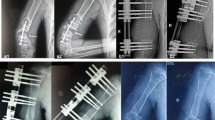Abstract
The Sauvé–Kapandji (SK) procedure is indicated in distal radius nonunion or malunion and distal radioulnar joint (DRUJ) instability. It can also be used to treat the rheumatoid wrist with severe degenerative changes in the DRUJ. The main objective is to allow a pain-free range of movement. We present a patient with rheumatoid arthritis and distal radius nonunion who, after three operations, was treated with the SK procedure. The clinical and radiological results were excellent. A 53-year-old woman diagnosed with rheumatoid arthritis fell on her forearm at home 2 years ago. Examination at an outpatient clinic revealed a distal radius fracture classified as type V according to the Frykman classification. She had been operated three times with open reduction internal fixation using a plate, screws, and bone allograft. She came to our institution with a distal radius nonunion, positive post-traumatic ulnar variance, and ulnar nerve paresis. The range of movements was 20°–10° flexion-extension and 40°–30° pronation–supination, and she needed daily fentanyl. We performed a modified SK procedure with an autologous iliac crest bone graft and ulnar bone graft from the osteotomy area (cubitus proradius), bone morphogenetic protein, and a low profile distal radius plate. After 1 year of follow-up, the distal radius fracture has healed and the wrist is pain-free with a complete range of movement in flexion-extension and pronation-supination. The main indication for the SK procedure is post-traumatic positive ulnar variance and associated ulnocarpal impaction. The cubitus proradius bone graft transposition is an interesting technical note that makes this case a challenge for skilled orthopedic hand surgeons.




Similar content being viewed by others
References
Rothwell AG, O’Neill L, Cragg K (1996) Sauve Kapandji procedure for disorders of the distal radioulnar joint: a simplified technique. J Hand Surg 21A:771–777
De Smet L (2006) The distal radioulnar joint in rheumatoid arthritis. Acta Orthop Belg 72(4):381–386
Slater RR Jr, Szabo RM (1998) The Sauve–Kapandji procedure. Tech Hand Up Extrem Surg 2(3):148–157. doi:10.1097/00130911-199809000-00002
Daecke W, Martini AK, Schneider S, Streich NA (2006) Amount of ulnar resection is a predictive factor for ulnar instability problems after the Sauve–Kapandji procedure: a retrospective study of 44 patients followed for 1–13 years. Acta Orthop 77(2):290–297. doi:10.1080/17453670610046055
Minami A, Iwasaki N, Ishikawa J, Suenaga N, Yasuda K, Kato H (2005) Treatments of osteoarthritis of the distal radioulnar joint: long-term results of three procedures. J Hand Surg 10(2–3):243–248
Lee SK, Hausman MR (2005) Management of the distal radioulnar joint in rheumatoid arthritis. Hand Clin 21(4):577–589. doi:10.1016/j.hcl.2005.08.009
Breen TF, Jupiter J (1989) Extensor carpi ulnaris and flexor carpi ulnaris tenodesis of the unstable distal ulna. J Hand Surg 14:612–617. doi:10.1016/0363-5023(89)90176-7
Lamey DM, Fernandez DL (1998) Results of the modified Sauve–Kapandji procedure in the treatment of chronic posttraumatic derangement of the distal radioulnar joint. J Bone Joint Surg 80:1758–1769
Metzger R, Andermahr J, Rehm E (2002) Malunion of the complex fracture of the distal radioulnar joint. Artificial Sauvé–Kapandji situation results in pain-free movements of the forearm and wrist. Eur J Trauma 6:370–373. doi:10.1007/s00068-002-1199-7
Ring D (2005) Treatment of neglected distal radius fracture. Clin Orthop Relat Res 431:85–92. doi:10.1097/01.blo.0000152442.66083.ff
Carter PB, Stuart PR (2000) The Sauvé Kapandji procedure for posttraumatic disorder of the distal radioulnar joint. J Bone Joint Surg Br 82B:1013–1018. doi:10.1302/0301-620X.82B7.10674
Ring D, Allende C, Jafarnia K, Allende B, Jupiter J (2004) Ununited diaphyseal forearm fractures with segmental defects: plate fixation and autogenous cancellous bone-grafting. J Bone Joint Surg 86:2440–2445
Shaaban H, Giakas G, Bolton M, Williams R, Wicks P, Scheker LR et al (2006) The load-bearing characteristics of the forearm: pattern of axial and bending force transmitted through ulna and radius. J Hand Surg [Br] 31(3):274–279. doi:10.1016/j.jhsb.2005.12.009
Minami A et al (1995) The Sauvé–Kapandji procedure for osteoarthritis of the distal radioulnar joint. J Hand Surg 20A:602–608
Author information
Authors and Affiliations
Corresponding author
Rights and permissions
About this article
Cite this article
Villamor, A., Rios-Luna, A., Villanueva-Martínez, M. et al. Nonunion of distal radius fracture and distal radioulnar joint injury: a modified Sauvé–Kapandji procedure with a cubitus proradius transposition as autograft. Arch Orthop Trauma Surg 128, 1407–1411 (2008). https://doi.org/10.1007/s00402-008-0708-5
Received:
Published:
Issue Date:
DOI: https://doi.org/10.1007/s00402-008-0708-5




